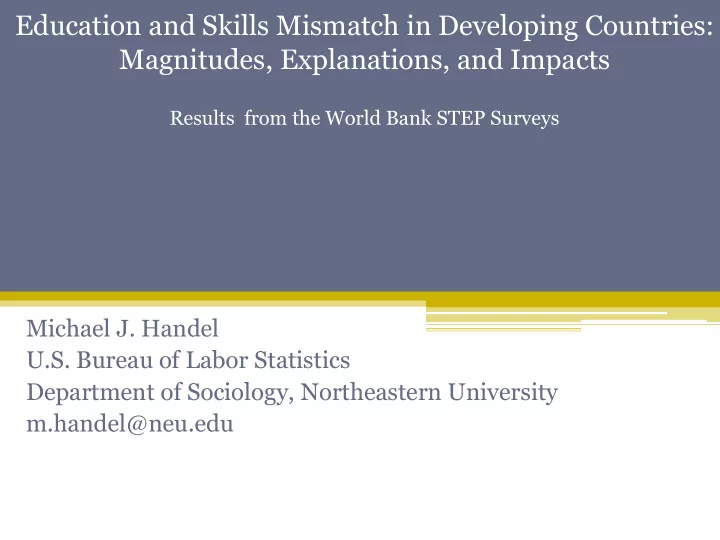

Education and Skills Mismatch in Developing Countries: Magnitudes, Explanations, and Impacts Results from the World Bank STEP Surveys Michael J. Handel U.S. Bureau of Labor Statistics Department of Sociology, Northeastern University m.handel@neu.edu
1 Rationale for mismatch research Persistent concerns in OECD countries (over decades) • Job skill requirements high and rising (accelerating?) • Education quality too low, rising too slowly, or falling • Worker skills are struggling to keep pace with job changes But research literature finds overeducation more common More shortage of skilled jobs than skilled workers Research on developing countries is sparse, generality of results and influence of distinctive contexts unknown
2 STEP samples • Urban households (mostly) • Random sample, working age (age 15-64) • Background survey + reading assessment (some countries, based on PIAAC) • Separate employer survey (some countries) 12 countries, almost all major regions (2012-2013) 1. Ghana 7. Bolivia (n=2,070) (n=1,206) 2. Kenya 8. Colombia (n=1,956) 3. China — Yunnan (n=1,268) 9. Armenia (n=972) 4. Lao 10. Georgia (n=1,283) (n=906) 5. Sri Lanka (n=579) 11. Macedonia (n=1,751) 6. Vietnam (n=2,183) 12. Ukraine (n=941) Serbia, Kosovo, and Philippines are in process
3 Distinctive issues in developing country contexts • Very high rates of informality, self-employment, micro-firms (55%-80%) • Very low employment rates among working age population (Europe/Central Asian countries, S. Asia) (33%-55%) o creates selection issues o unemployment/inactivity a form of mismatch • Both reflect very weak job market, low job generation (or gender dynamics)
4 Persistent methodological issue How to measure mismatch? • education level (various methods) • skill level (various methods) Many ways to compare workers and jobs different results Measure person and job characteristics on same scale to permit direct person-job comparisons (not always possible, e.g. test scores) Focus will be on education mismatch Personal attainment vs. Reported job educ. requirements Source: Michael J. Handel, Alexandria Valerio, and Maria Laura Sanchez Puerta, Accounting for Mismatch in Low- and Middle-Income Countries: Measurement, Magnitudes, and Explanations. (2016, World Bank)
5 Examples of STEP job task measures Reading, Writing Level 1. Anything 2. Length of longest document read normally (<1 page, 2-5, 6-10, 11-25, >25) Kind • Forms, bills • Manuals, reports • Newspapers, magazines, books Math Level 1. Anything 2. Measure sizes, weights, distances, calculate prices/costs 3. Use/calculate fractions, decimals, percentages 4. Other multiplication, division 5. Advanced math (e.g., algebra, geometry, trigonometry) General cognitive Problem-solving: How often perform tasks requiring 30 minutes thinking to figure out what to do (e.g., mechanic fixing a car) (never-every day)
6 Non-objective measures? Best to avoid • ‘ Does your main job involve complex tasks’ (yes/no) European Working Conditions Survey (EU) (1990-present, every 5 years) • ‘My job is complex and difficult’ (strongly agree-strongly disagree) Household, Income and Labour Dynamics (HILDA) (Australia’s panel survey) Items apply to everyone, but not very explicit — too general, subjective Low information content — not clear what answers mean Michael J. Handel (2017), “Measuring Job Content: Skills, Technology, and Management Practices ,” in Oxford Handbook of Skills and Training, John Buchanan, et al., eds. Oxford: Oxford University Press.
Analyses 7 Focus 1. Incidence of mismatch in developing countries 2. Explanations A. Small when measured correctly (frictions, transitory, “preferences”) B. School failure (low achievement, “wrong” fields of study) C. Job market failure (low employment rates, low investment informality) 3. Consequences of mismatch
8 Education of employed persons, STEP countries
9 Education required by job across STEP countries
10 Match and Mismatch rates, STEP countries
11 One point calling for more explanation… Over-education more common than under-education in low- and middle-income countries, as well as OECD Lower prevalence of under-education may be explicable — overqualified more likely to be hired than underqualified But why so much over-education in low-education countries, when policy advice emphasizes raising education levels? Same issue in OECD countries — how to reconcile rising university premium with persistent underutilization of university graduates? If there is shortage of tertiary grads, why are so many not absorbed?
12 Match and Mismatch rates, STEP countries
13 Different forms of possible match and mismatch Job skill requirements Worker skills Low Medium High Low 1 2 3 Medium 4 5 6 High 7 8 9 (2,3,6) Job skill requirements > worker skills (1) Low-skill match (worst) (5) Medium-skill match Firms lower hiring standards (under-education) (9) High-skill match (best) (4,7,8) Jobs requirements < worker skills Workers lower job expectations (over-education) Matches on diagonal — but not all are desirable: (1) is worst-case, (9) is best case Ranking of under-education and over-education more ambiguous (but not optimal) This model of match and mismatch is starting point and focus here, Skills = Education
Recommend
More recommend